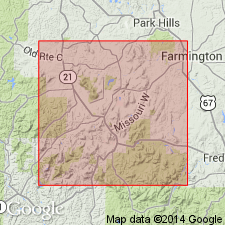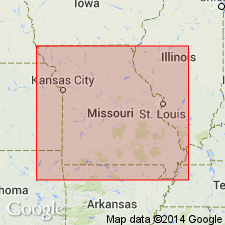
- Usage in publication:
-
- Clark Mountain rhyolite
- Modifications:
-
- First used
- Dominant lithology:
-
- Porphyry
- [Rhyolite]
- AAPG geologic province:
-
- Midcontinent region
Summary:
Clark Mountain rhyolite (new) of Middlebrook group (new). Briefly summarized in reports by W.C. Hayes and J.A. Martin, p. 35, 36, and W.C. Hayes, p. 83 (table 1), this volume. New names are credited to Tolman and Robertson (in prep.) [1969, Missouri Div. Geol. Survey Water Res. Rpt. Inv., no. 44 (Contrib. to Precambrian Geol., no. 1)]. An aphanitic reddish-brown to grayish-purple porphyry with phenocrysts of light-brown to light-red feldspar. Upper part of unit consists of flow breccia as much as 550 feet thick. Entire thickness may be over 1,000 feet. Age is Precambrian.
Occurs in Wayne and Reynolds Cos., St. Francois Mountain area. Samples of rhyolite collected in SW/4 NW/4 sec. 18, T. 29 N., R. 4 E., Wayne Co. Clark Mountain is in Wayne Co., northeast of Piedmont, southeastern MO.
Source: Modified from US geologic names lexicon (USGS Bull. 1350, p. 155-156).

- Usage in publication:
-
- Clark Mountain rhyolite
- Modifications:
-
- Principal reference
- Dominant lithology:
-
- Rhyolite
- AAPG geologic province:
-
- Midcontinent region
Summary:
Clark Mountain rhyolite of Middlebrook group. A flow breccia exposed in St. Francois Mountains, southeastern Missouri, notably on Clark Mountain (type area), Finley Mountain, Haley Mountain, and Frenchman Hill. Consists of angular blocks, averaging a foot in diameter, in a dense reddish-brown to grayish-purple-brown aphanitic groundmass. Epidote stringers occur locally; flow structures are well developed especially near top. Cavities are at least a foot in minimum dimension. Weathers to large residual boulders 30 to 50 feet high. In type area, groundmass contains light-brown potash feldspar phenocrysts exhibiting a reddish cast, and a few quartz phenocrysts; in places, top of flow is a chilled and fractured crust. On Finley Mountain, groundmass contains red potash feldspar phenocrysts exhibiting a purple cast and quartz phenocrysts are more abundant; near top of flow, rocks have brilliant red splotches. Thickness 550 feet in type area. Entire flow is over 1,000 feet thick making it one of thickest flows in region; covers at least 60 sq mi with volume of 12 cu mi. Age is Precambrian.
Type area: exposures on Clark Mountain, about 4 mi northeast of Piedmont, in sec. 13, T. 29 N., R. 3 E., and in secs. 17 and 18, T. 29 N., R. 4 E., Wayne Co., southeastern MO.
[GNU remark (February 16, 1990, USGS DDS-6; Denver GNULEX): Stratigraphic relationships of units of Middlebrook not discussed in text; geologic map (plate 1) missing from library copy of report.]
[GNC remark (February 29, 2008): It appears that †Clark Mountain rhyolite of †Middlebrook group has not been applied to these rocks since this publication. Considered abandoned.]
Source: Modified from GNU records (USGS DDS-6; Denver GNULEX).
For more information, please contact Nancy Stamm, Geologic Names Committee Secretary.
Asterisk (*) indicates published by U.S. Geological Survey authors.
"No current usage" (†) implies that a name has been abandoned or has fallen into disuse. Former usage and, if known, replacement name given in parentheses ( ).
Slash (/) indicates name conflicts with nomenclatural guidelines (CSN, 1933; ACSN, 1961, 1970; NACSN, 1983, 2005, 2021). May be explained within brackets ([ ]).

